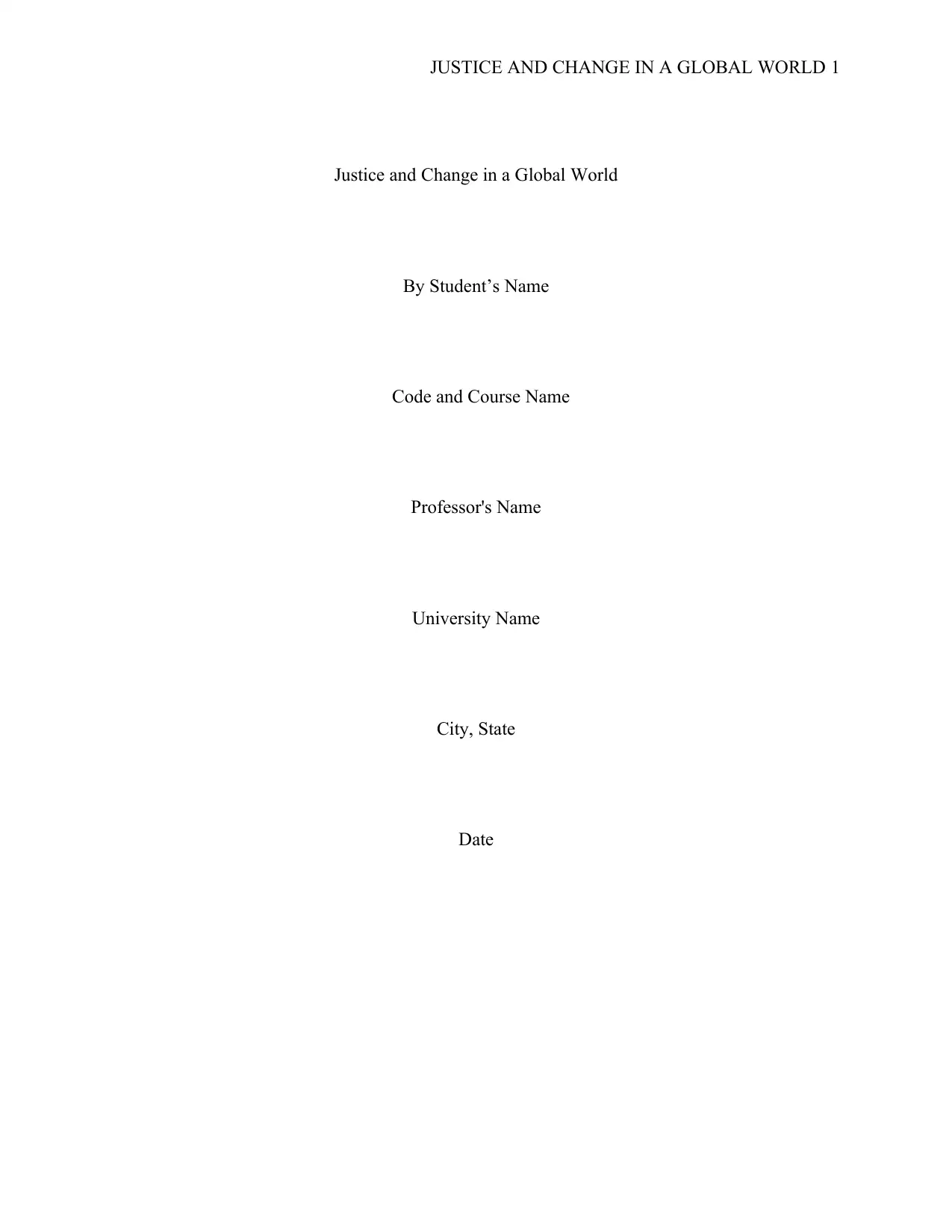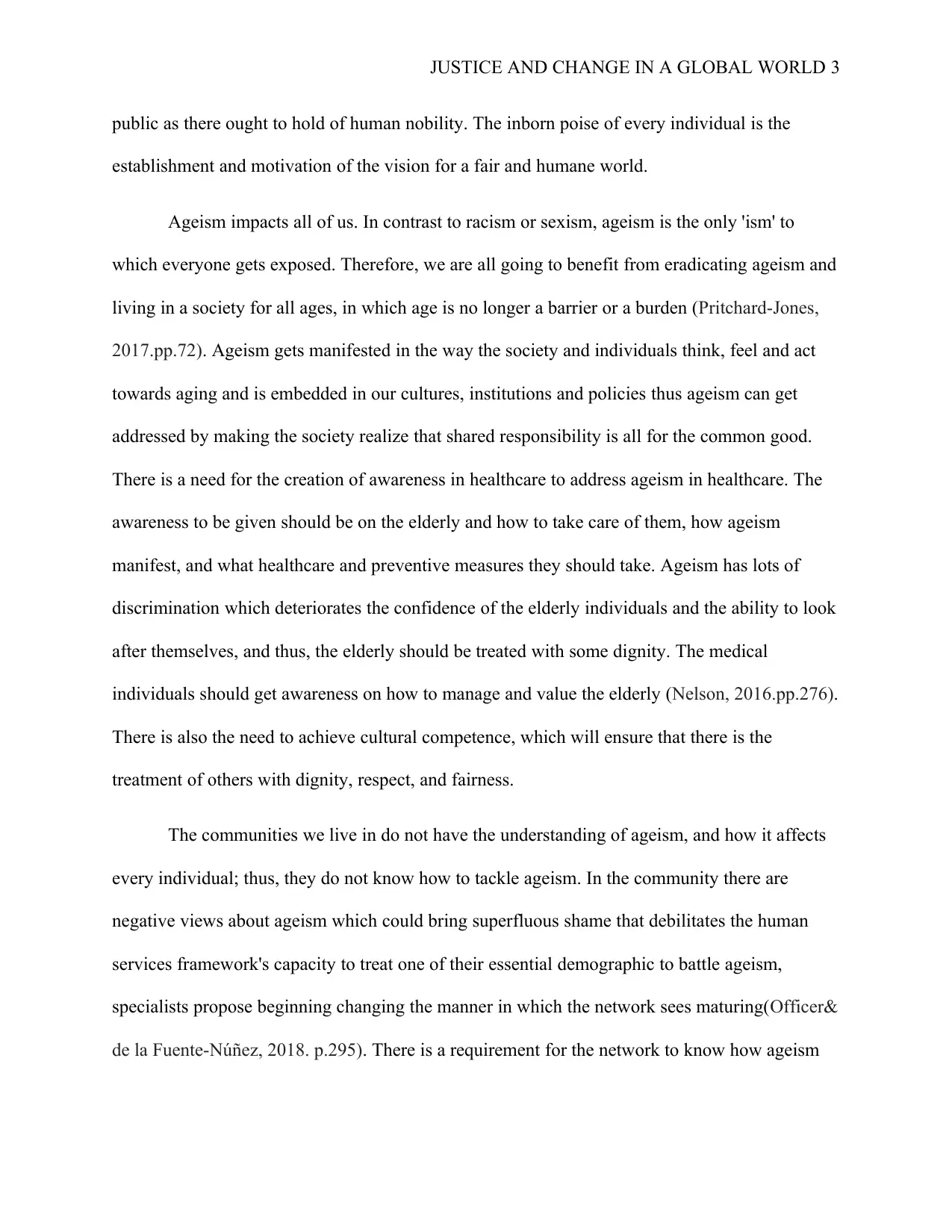Analyzing Ageism in Healthcare: Justice and Change in the World
VerifiedAdded on 2023/03/31
|6
|1281
|241
Essay
AI Summary
This essay examines the issue of ageism within healthcare systems, focusing on its manifestation, impact, and potential solutions from a global perspective. It highlights how ageism, a form of discrimination against the elderly, affects the quality of care and the overall well-being of older individuals. The essay draws upon research and ethical frameworks, including Roman Catholic principles, to advocate for a more just and humane approach to elderly care. It emphasizes the need for increased awareness, cultural competence, and societal reframing to combat ageism. The essay further suggests practical measures, such as educational programs for healthcare professionals and community initiatives, to promote dignity, respect, and improved healthcare outcomes for the elderly on both local and global scales, advocating for shared responsibility in ensuring the well-being of older adults.

JUSTICE AND CHANGE IN A GLOBAL WORLD 1
Justice and Change in a Global World
By Student’s Name
Code and Course Name
Professor's Name
University Name
City, State
Date
Justice and Change in a Global World
By Student’s Name
Code and Course Name
Professor's Name
University Name
City, State
Date
Paraphrase This Document
Need a fresh take? Get an instant paraphrase of this document with our AI Paraphraser

JUSTICE AND CHANGE IN A GLOBAL WORLD 2
In healthcare, ageism is a representation of the discrimination that is experienced by the
elderly, which is subconscious more so in the provision of medical care. Some perceptions are
given on elderly individuals by healthcare professionals. There are also cultural attitudes that
have contributed to elderly individuals getting poor healthcare services. In research done in
2007, showed that there is about 13% of the elderly population. In that percentage of the elderly,
there are about 80% of the people in Australia above the age of 60 years, and they have
experienced ageism.
Ageism is dangerous, and in a world that isn't yet prepared to surrender its presumptions,
it will just deteriorate. Like different types of segregation, ageism can possibly get turned around
in the event that it initially gets switched in the person (Kydd&Fleming, 2015. pp.432). The
media, as an impression of culture, will never again discover a market in ageism jokes and
welcome cards. At long last, the old population itself must be affected by ageism and thus they
should know of ageism, the elderly individuals should get to acknowledge separation since they
don't have the precise idea about their rights. Ageism has gotten little thought in research and
game plan making, and the confirmation base for overall movement is yet to get developed.
There is no general examination on the span of ageism, its determinants, results, and what
strategies and messages could work to address ageism. There is loads of issue with
understanding the mutual obligation regarding the benefit of all (Band-Winterstein, 2015.
pp.NP113). The Roman Catholic characterizes empowers people or various gatherings to achieve
their satisfaction all the more productively and also educate them on human dignity. Each
individual is made in Gods image and thus every individual needs to be treated right and be
respected as each life is sacrosanct. In this manner there ought not to be ageism in the general
In healthcare, ageism is a representation of the discrimination that is experienced by the
elderly, which is subconscious more so in the provision of medical care. Some perceptions are
given on elderly individuals by healthcare professionals. There are also cultural attitudes that
have contributed to elderly individuals getting poor healthcare services. In research done in
2007, showed that there is about 13% of the elderly population. In that percentage of the elderly,
there are about 80% of the people in Australia above the age of 60 years, and they have
experienced ageism.
Ageism is dangerous, and in a world that isn't yet prepared to surrender its presumptions,
it will just deteriorate. Like different types of segregation, ageism can possibly get turned around
in the event that it initially gets switched in the person (Kydd&Fleming, 2015. pp.432). The
media, as an impression of culture, will never again discover a market in ageism jokes and
welcome cards. At long last, the old population itself must be affected by ageism and thus they
should know of ageism, the elderly individuals should get to acknowledge separation since they
don't have the precise idea about their rights. Ageism has gotten little thought in research and
game plan making, and the confirmation base for overall movement is yet to get developed.
There is no general examination on the span of ageism, its determinants, results, and what
strategies and messages could work to address ageism. There is loads of issue with
understanding the mutual obligation regarding the benefit of all (Band-Winterstein, 2015.
pp.NP113). The Roman Catholic characterizes empowers people or various gatherings to achieve
their satisfaction all the more productively and also educate them on human dignity. Each
individual is made in Gods image and thus every individual needs to be treated right and be
respected as each life is sacrosanct. In this manner there ought not to be ageism in the general

JUSTICE AND CHANGE IN A GLOBAL WORLD 3
public as there ought to hold of human nobility. The inborn poise of every individual is the
establishment and motivation of the vision for a fair and humane world.
Ageism impacts all of us. In contrast to racism or sexism, ageism is the only 'ism' to
which everyone gets exposed. Therefore, we are all going to benefit from eradicating ageism and
living in a society for all ages, in which age is no longer a barrier or a burden (Pritchard-Jones,
2017.pp.72). Ageism gets manifested in the way the society and individuals think, feel and act
towards aging and is embedded in our cultures, institutions and policies thus ageism can get
addressed by making the society realize that shared responsibility is all for the common good.
There is a need for the creation of awareness in healthcare to address ageism in healthcare. The
awareness to be given should be on the elderly and how to take care of them, how ageism
manifest, and what healthcare and preventive measures they should take. Ageism has lots of
discrimination which deteriorates the confidence of the elderly individuals and the ability to look
after themselves, and thus, the elderly should be treated with some dignity. The medical
individuals should get awareness on how to manage and value the elderly (Nelson, 2016.pp.276).
There is also the need to achieve cultural competence, which will ensure that there is the
treatment of others with dignity, respect, and fairness.
The communities we live in do not have the understanding of ageism, and how it affects
every individual; thus, they do not know how to tackle ageism. In the community there are
negative views about ageism which could bring superfluous shame that debilitates the human
services framework's capacity to treat one of their essential demographic to battle ageism,
specialists propose beginning changing the manner in which the network sees maturing(Officer&
de la Fuente-Núñez, 2018. p.295). There is a requirement for the network to know how ageism
public as there ought to hold of human nobility. The inborn poise of every individual is the
establishment and motivation of the vision for a fair and humane world.
Ageism impacts all of us. In contrast to racism or sexism, ageism is the only 'ism' to
which everyone gets exposed. Therefore, we are all going to benefit from eradicating ageism and
living in a society for all ages, in which age is no longer a barrier or a burden (Pritchard-Jones,
2017.pp.72). Ageism gets manifested in the way the society and individuals think, feel and act
towards aging and is embedded in our cultures, institutions and policies thus ageism can get
addressed by making the society realize that shared responsibility is all for the common good.
There is a need for the creation of awareness in healthcare to address ageism in healthcare. The
awareness to be given should be on the elderly and how to take care of them, how ageism
manifest, and what healthcare and preventive measures they should take. Ageism has lots of
discrimination which deteriorates the confidence of the elderly individuals and the ability to look
after themselves, and thus, the elderly should be treated with some dignity. The medical
individuals should get awareness on how to manage and value the elderly (Nelson, 2016.pp.276).
There is also the need to achieve cultural competence, which will ensure that there is the
treatment of others with dignity, respect, and fairness.
The communities we live in do not have the understanding of ageism, and how it affects
every individual; thus, they do not know how to tackle ageism. In the community there are
negative views about ageism which could bring superfluous shame that debilitates the human
services framework's capacity to treat one of their essential demographic to battle ageism,
specialists propose beginning changing the manner in which the network sees maturing(Officer&
de la Fuente-Núñez, 2018. p.295). There is a requirement for the network to know how ageism
⊘ This is a preview!⊘
Do you want full access?
Subscribe today to unlock all pages.

Trusted by 1+ million students worldwide

JUSTICE AND CHANGE IN A GLOBAL WORLD 4
shows and have the option to perceive the ageist circumstance, particularly inside the social
insurance framework.
Locally there is a lack of awareness in deciding how the benefit of everyone influences
both expert progressions and practices in the medicinal services framework. Social orders have a
background marked by reinforcing and supporting medicinal services as a calling for instance
through the steady advancement of conceptualization, improvement of cutting edge human
services callings just as practices, for example, human services specialists, just as usage(Ünal
&Turgut, 2017. pp.1). This can be unraveled by creating data devices and approaches to help
society "reframe" or change their comprehension and impression of the maturing procedure. This
reframing, they state, can prompt changing arrangement for the improvement of more seasoned
ages. Likewise, there could be a backer for inhabitants of nursing homes who could get the
opportunity to represent the old. It would be a program that would get the chance to help with
settling issues for older people just as working at the neighborhood, state, and national
dimensions to improve care and personal satisfaction (World Health Organization, 2014. n. p). It
would likewise guarantee that local people get illuminated on dealing with the older and
guaranteeing they know how they ought to get drug.
Globally there is a problem of the hospitals getting nurses who know how to handle and
treat the elderly. This can be solved through ensuring that the healthcare individuals get to learn
on taking care of the elderly and appreciating them. It is made possible by ensuring that it gets
covered in their curriculum (Levy, 2016. pp.226). It can be implemented by ensuring that the
medical individuals as they apply for jobs get to show evidence of covering how to take care of
the elderly.
shows and have the option to perceive the ageist circumstance, particularly inside the social
insurance framework.
Locally there is a lack of awareness in deciding how the benefit of everyone influences
both expert progressions and practices in the medicinal services framework. Social orders have a
background marked by reinforcing and supporting medicinal services as a calling for instance
through the steady advancement of conceptualization, improvement of cutting edge human
services callings just as practices, for example, human services specialists, just as usage(Ünal
&Turgut, 2017. pp.1). This can be unraveled by creating data devices and approaches to help
society "reframe" or change their comprehension and impression of the maturing procedure. This
reframing, they state, can prompt changing arrangement for the improvement of more seasoned
ages. Likewise, there could be a backer for inhabitants of nursing homes who could get the
opportunity to represent the old. It would be a program that would get the chance to help with
settling issues for older people just as working at the neighborhood, state, and national
dimensions to improve care and personal satisfaction (World Health Organization, 2014. n. p). It
would likewise guarantee that local people get illuminated on dealing with the older and
guaranteeing they know how they ought to get drug.
Globally there is a problem of the hospitals getting nurses who know how to handle and
treat the elderly. This can be solved through ensuring that the healthcare individuals get to learn
on taking care of the elderly and appreciating them. It is made possible by ensuring that it gets
covered in their curriculum (Levy, 2016. pp.226). It can be implemented by ensuring that the
medical individuals as they apply for jobs get to show evidence of covering how to take care of
the elderly.
Paraphrase This Document
Need a fresh take? Get an instant paraphrase of this document with our AI Paraphraser

JUSTICE AND CHANGE IN A GLOBAL WORLD 5
In conclusion, there is the social change that is required, and it can be coordinated and get
sustained by private or public sectors that will ensure an action that is solid and continuous for
the elderly and for the society. There is a need for a broader coalition between the society and the
medical care field to establish and get to establish a society that knows the importance and have
the need to make positive changes in the thinking of the society, acts and feels towards ageism.
These changes will bring changes in the attitudes towards ageism and how the individuals can
work together to make changes and ensure the wellbeing and good health for everyone and more
so the elderly.
In conclusion, there is the social change that is required, and it can be coordinated and get
sustained by private or public sectors that will ensure an action that is solid and continuous for
the elderly and for the society. There is a need for a broader coalition between the society and the
medical care field to establish and get to establish a society that knows the importance and have
the need to make positive changes in the thinking of the society, acts and feels towards ageism.
These changes will bring changes in the attitudes towards ageism and how the individuals can
work together to make changes and ensure the wellbeing and good health for everyone and more
so the elderly.

JUSTICE AND CHANGE IN A GLOBAL WORLD 6
References
Band-Winterstein, T., 2015. Health care provision for older persons: the interplay between
ageism and elder neglect. Journal of Applied Gerontology, 34(3), pp.NP113-NP127.
Kydd, A. and Fleming, A., 2015. Ageism and age discrimination in health care: Fact or
fiction? A narrative review of the literature. Maturitas, 81(4), pp.432-438.
Levy, S.R., 2016. Toward reducing ageism: PEACE (positive education about aging and
contact experiences) model. The Gerontologist, 58(2), pp.226-232.
Nelson, T.D., 2016. Promoting healthy aging by confronting ageism. American
Psychologist, 71(4), p.276.
Officer, A. and de la Fuente-Núñez, V., 2018. A global campaign to combat ageism. Bulletin
of the World Health Organization, 96(4), p.295.
Pritchard-Jones, L., 2017. Ageism and autonomy in health care: Explorations through a
relational lens. Health Care Analysis, 25(1), pp.72-89.
Ünal, Z.M. and Turgut, T., 2017. The existential motivation: Searching for meaning-the
contribution of meaningful work on meaning in life. Methods, 20(1), pp.1-8.
World Health Organization, Ageing and life course. Geneva: World Health Organization;
2014.
References
Band-Winterstein, T., 2015. Health care provision for older persons: the interplay between
ageism and elder neglect. Journal of Applied Gerontology, 34(3), pp.NP113-NP127.
Kydd, A. and Fleming, A., 2015. Ageism and age discrimination in health care: Fact or
fiction? A narrative review of the literature. Maturitas, 81(4), pp.432-438.
Levy, S.R., 2016. Toward reducing ageism: PEACE (positive education about aging and
contact experiences) model. The Gerontologist, 58(2), pp.226-232.
Nelson, T.D., 2016. Promoting healthy aging by confronting ageism. American
Psychologist, 71(4), p.276.
Officer, A. and de la Fuente-Núñez, V., 2018. A global campaign to combat ageism. Bulletin
of the World Health Organization, 96(4), p.295.
Pritchard-Jones, L., 2017. Ageism and autonomy in health care: Explorations through a
relational lens. Health Care Analysis, 25(1), pp.72-89.
Ünal, Z.M. and Turgut, T., 2017. The existential motivation: Searching for meaning-the
contribution of meaningful work on meaning in life. Methods, 20(1), pp.1-8.
World Health Organization, Ageing and life course. Geneva: World Health Organization;
2014.
⊘ This is a preview!⊘
Do you want full access?
Subscribe today to unlock all pages.

Trusted by 1+ million students worldwide
1 out of 6
Related Documents
Your All-in-One AI-Powered Toolkit for Academic Success.
+13062052269
info@desklib.com
Available 24*7 on WhatsApp / Email
![[object Object]](/_next/static/media/star-bottom.7253800d.svg)
Unlock your academic potential
Copyright © 2020–2025 A2Z Services. All Rights Reserved. Developed and managed by ZUCOL.





